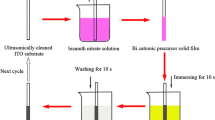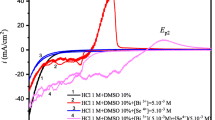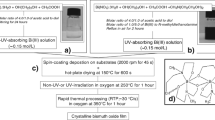Abstract
The rapidly quenched films in the Bi2O3-TiO2 system (0 to 60% TiO2) were prepared using a twin-roller type apparatus. The films precipitated Bi2O3 solid solutions of different types in the composition ranges, with TiO2 contents of 0 to 5, 7.5 to 10 and 12.5 to 40%, respectively. The first solid solution had a tetragonal structure of β-form. The second, though also crystallized in the tetragonal structure, adopted a disordered modification of the β-form. The third solid solution was δ-form (defect fluorite structure). The formation of amorphous phase commenced in the composition with 30% TiO2, and the films became completely amorphous beyond 50% TiO2. The quenched films showed a certain instability to decompose or transform into the different phase assemblage by annealing at higher temperatures (about 400 to 500° C, except 260° C for the pure Bi2O3 film). The quenched films were also characterized by a high photoconductivity. The photoconduction mechanism was suggested to be associated with a structural imperfection of Bi2O3 accompanied by a certain amount of pentavalent bismuth ion.
Similar content being viewed by others
References
R. E. Aldrich, S. L. Hou and M. L. Harvill, J. Appl. Phys. 42 (1977) 493.
S. L. Hou and D. S. Oliver, Appl. Phys. Lett. 18 (1971) 325.
J. M. Mitsuyu, K. Wasa and S. Hayakawa, J. Crystal Growth 41 (1977) 151.
S. Efendief, V. E. Bagiev, A. C. Zeinally, V. A. Balashov, V. A. Lomonov and A. Majer, Phys. Status Solidi (a) 63 (1981) K19.
T. Sekiya, A. Tsuzuki and Y. Torii, Mater. Res. Bull. 20 (1985) 1383.
T. Sekiya, A. Tsuzuki and Y. Tirii, ibid. 21 (1986) 601.
M. Tatsumisago, T. Minami and M. Tanaka, J. Amer. Ceram. Soc. 64 (1982) C-97.
E. M. Levin and R. S. Roth, J. Res. Nat. Bur. Stand. 68A (1964) 197.
T. M. Bruton, J. Solid State Chem. 9 (1974) 173.
G. Gattow and D. Schutze, Z. Anorg. Allg. Chem. 328 (1964) 44.
H. A. Harwig, ibid. 444 (1978) 151.
R. K. Datta and J. P. Meehan, ibid. 383 (1971) 328.
T. Takahashi, H. Iwahara and Y. Nagai, J. Appl. Electrochem. 2 (1972) 97.
T. Takahashi and H. Iwahara, ibid. 3 (1973) 65.
T. Takahashi, H. Iwahara and T. Easka, J. Electrochem. Soc. 124 (1977) 1563.
M. J. Verkerk, K. Keizer and J. Burgraaf, J. Appl. Electrochem. 10 (1980) 81.
T. Suzuki and S. Ukawa, J. Mater. Sci. 18 (1983) 1845.
T. Sekiya and Y. Torii, Mater. Res. Bull. 19 (1984) 885.
F. K. Lotgering, J. Inorg. Nucl. Chem. 9 (1959) 113.
Author information
Authors and Affiliations
Rights and permissions
About this article
Cite this article
Sekiya, T., Tzuzuki, A., Kawakami, S. et al. Preparation and photoconduction of rapidly quenched films in the Bi2O3-TiO2 system. J Mater Sci 23, 3300–3304 (1988). https://doi.org/10.1007/BF00551309
Received:
Accepted:
Issue Date:
DOI: https://doi.org/10.1007/BF00551309




